Developing an agent for SCML2024 (Standard)
In 2024, we introduced a new implementation of the SCML-Standard track which simplified its API making it exactly the same as the simpler SCML-OneShot track. The older version of the game is not supported anymore.
SCML-Std brief introduction Please refer to the first tutorial for a brief introduction about the world simulated in this game as well as pointers to more information. We will assume knowledge of at least this brief introduction in the remainder of this tutorial.
The main differences between the Standard and OneShot simulation that will affect this tutorial are the following:
Agents can negotiate future contracts instead of only being allowed to negotiate about deliveries on the same day. This means that we better consider future contracts when negotiating instead of trying to secure all of our needs on the day they arise.
Negotiated prices have a larger range which necessitates reasoning about prices as well as quantity matching. This means that we should be careful about accepting good prices (i.e. low prices when buying and high prices when selling).
Production graphs can be deeper which means that some agents will negotiate with both their suppliers and consumers at the same time. This means that our agent may find itself in the middle of the production graph with no exogenous contracts. In such cases, the agent may set some target production level and try to achieve it instead of relying on its exogenous contracts to set its targets.
First things first, let’s create some helper functions that will allow us to evaluate different agents we develop in this tutorial.
Here we use the WorldRunner class which is designed to allow us to
compare multiple agents in exactly the same conditions. To create a
WorldRunner, you need to pass a context which is used for generating
the worlds in which the agents are evaluated. the SCML package defines
several contexts that allow us to control these worlds. For example the
StrongSupplierContext will always create worlds in which the agent
being evaluated is in the first production level \(L_0\) with more
agents on this level than on the next level. You cand define your own
contexts for experimenting with specific conditions (e.g. specific
exogenous contract distribution, market structure, etc). The most
general context which will produce any world that your agent may
encounter in the ANAC comptition is the
ANACOneShotContext for one-shot worlds and ANACStdContext for
standard worlds.
We create two runners:
single_agent_runner in which a single agent is being evaluated while the rest of the agents are sampled randomly from a subset of SCML built-in agents.
full_market_runner in which all agents in the market are controlled by the agent type being evaluated. This may be helpful in understanding how your agent behaves in this extreme condition but can be misleading as an estimate of the agent’s performance in the official ANAC competition.
We are using a relatively large nubmer of configurations, repetitions per configuration and steps (days) per repetition. If you are running this notebook for the first time, consider reducing CONFIGS, REPS, STEPS above to make it run faster.
This is time to describe some of the tools that the WorldRunner
gives you to evaluate the agent. The WorldRunner is a Callable. You
just call it with the class (agent type) you want to evaluate. You can
optionally pass parameters if you would like to compared different
parameters for example. Remember in this case to also pass a name to
differentiate between different parameter choices.
import pandas as pd
import math
from typing import Iterable
from rich.jupyter import print
from negmas import SAOResponse, ResponseType, Outcome, SAOState
from scml.std import *
from scml.runner import WorldRunner
# create a runner that encapsulates a number of configs to evaluate agents
# in the same conditions every time
CONFIGS, REPS, STEPS = 10, 3, 50
context = ANACStdContext(
n_steps=STEPS, n_processes=3, world_params=dict(construct_graphs=True)
)
single_agent_runner = WorldRunner(
context, n_configs=CONFIGS, n_repetitions=REPS, save_worlds=True
)
full_market_runner = WorldRunner.from_runner(
single_agent_runner, control_all_agents=True
)
Testing a completely random agent
Let’s try an agent that behaves randomly:
full_market_runner(RandomStdAgent);
We can use the runner now to display the worlds for a given type that we evaluated:
full_market_runner.draw_worlds_of(RandomStdAgent);

Lots of contracts have been reached, but were they good contracts? We can use the runner now to plot several statistics (e.g. shortfall-penalty, disposal-cost, productivity, and score in this example). There are more than 42 such statistics that you can display.
full_market_runner.plot_stats(agg=False);
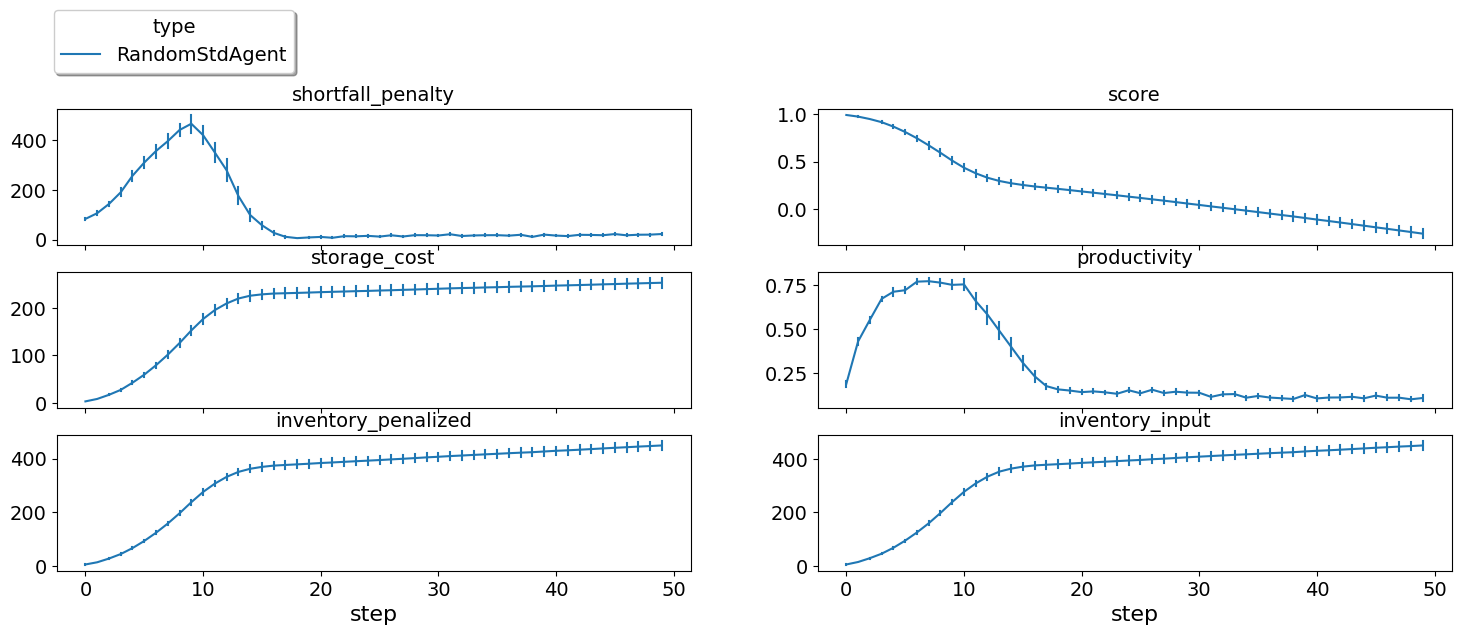
The score is going down monotonically showing that this random agent
is losing money every step. It is clear that the agent gets too high
shortfall penalty and storage cost. The inventory_input plot shows
the amount of the input product in the inventory at the end of each
simulation step. It is clear that the agent accomulates too much of this
product as it cannot sell it when it is in the first production level
and seems to buy too much when it is in the last production level.
This score is much lower than what we got in the oneshot world. Some of the reasons for that are the following:
In the standard game, the range of prices is large enough that price matters. Choosing a random price is not a good idea here. In the oneshot game, on the other hand, price range was extremely small that the price did not really matter.
In the oneshot game, all negotiations happen about deliveries on the same day and products are perishable so you do not accomulate stock over time. In the standard game, on the other hand, negotiations are about deliveries on the same day or the future. Picking randomly from those will reduce the probability of picking what you need today and increase the probability of picking something you do not really need in the future.
Now we are ready to develop a do-nothing agent, but first, let’s try some of the built in agents to see how do they behave.
full_market_runner(SyncRandomStdAgent)
full_market_runner(GreedyStdAgent);
We can also add a couple of one-shot agents in the mix
from scml.oneshot.agents import *
full_market_runner(RandomOneShotAgent)
full_market_runner(GreedyOneShotAgent)
full_market_runner(RandDistOneShotAgent)
full_market_runner(EqualDistOneShotAgent);
and look at the final results:
full_market_runner.plot_stats(stats="score");
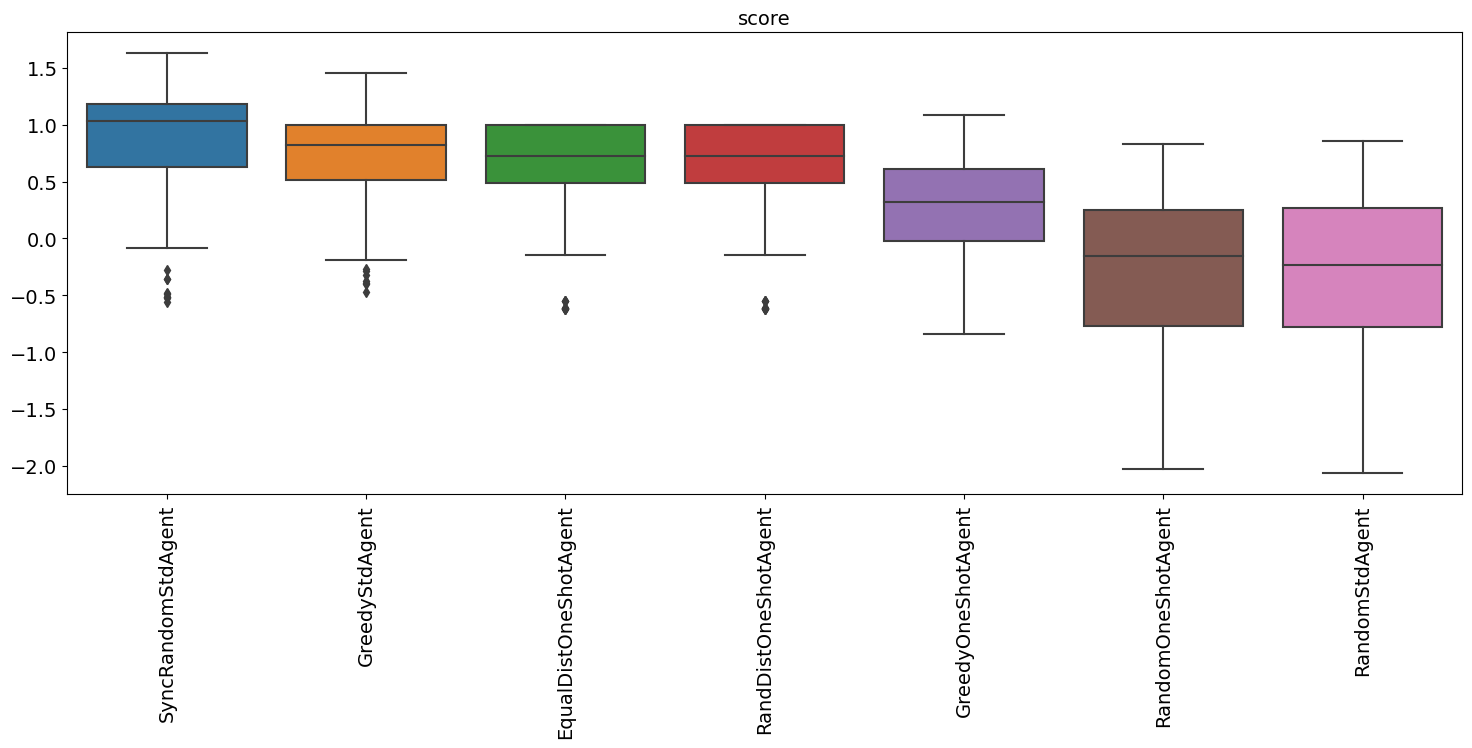
The two builtin agents behaved roughly similarliy and outperformed all one-shot agents even though the random std agent is even worse than the random one-shot agent (because it samples from a much larger outcome space).
Note that this test was when the agent controller every factory in the
market. This is very different than the ANAC competition in whic the
agent controls a single agent. Luckily, we already have a runner that
tests exactly this case. Let’s see how does RandomStdAgent behave in
such cases:
single_agent_runner(RandomStdAgent);
single_agent_runner.plot_stats(agg=False);
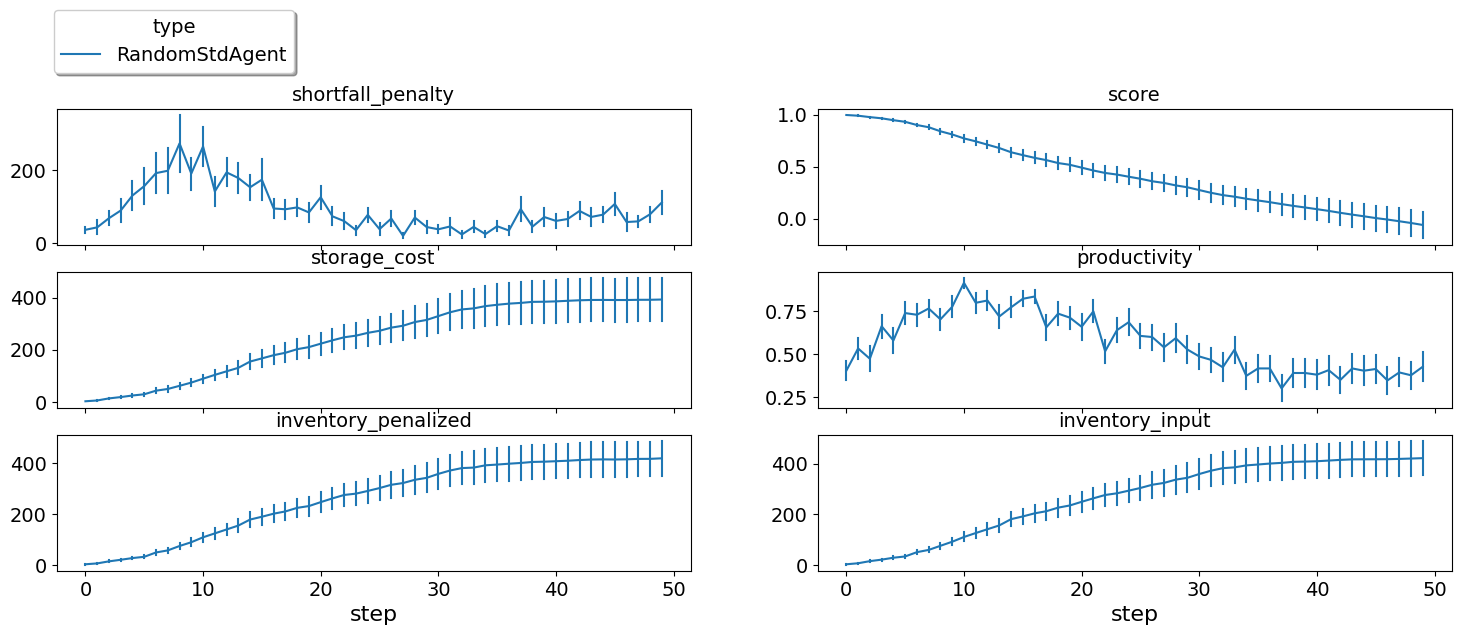
Still losing money at the same level. The fact that other agents made
sense did not help our random agent get higher score. This is very
different from the one-shot case (if you have already checked the
previous tutorial). We can now check the distribution of scores for our
agent using the score_summary method:
single_agent_runner.score_summary()
| type | score | count | mean | std | min | 25% | 50% | 75% | max | |
|---|---|---|---|---|---|---|---|---|---|---|
| 0 | RandomStdAgent | -0.061693 | 30.0 | -0.061693 | 0.708594 | -1.504509 | -0.510917 | -0.183504 | 0.474423 | 0.981504 |
Now, we are ready to start working on our agent.
A do-nothing agent
class MyStdDoNothing(StdPolicy):
"""My Agent that does nothing"""
def act(self, state):
return {}
single_agent_runner(MyStdDoNothing)
single_agent_runner.draw_worlds_of(MyStdDoNothing);
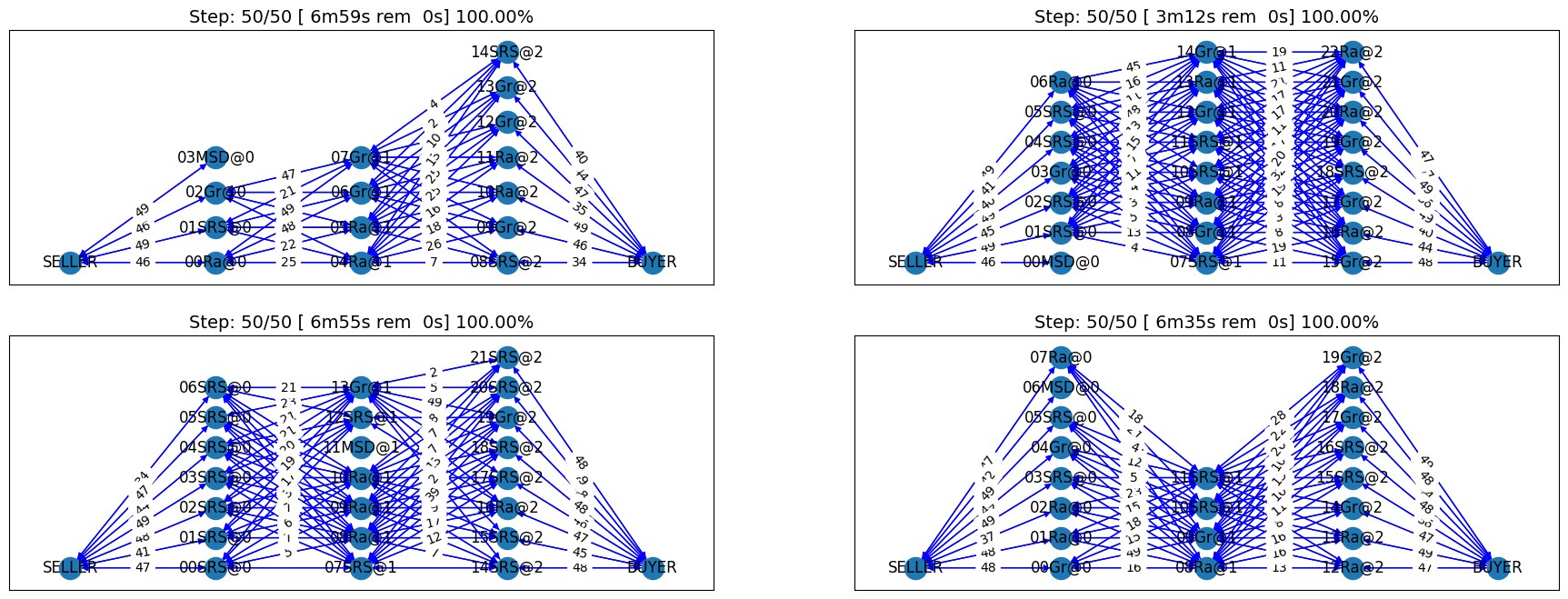
In all of the graph representing world simulations, we use short names
that represent the type of the agent. For example an agent named
01Gr@0 is an agent of type GreedyStdAgent at production level 1
that was the third agent to create. MSD here is a shorthand for
MyStdDoNothingAgent.
Looking at the contracts-signed, we can see that none of the
concluded contracts involved our do-nothing agent. Nevertheless, these
agents still had exogenous contracts which means that they will lose
money. A do-nothing agent will usually lose money in this game.
Let’s check the scores of different agents to confirm:
single_agent_runner.plot_stats(agg=False);
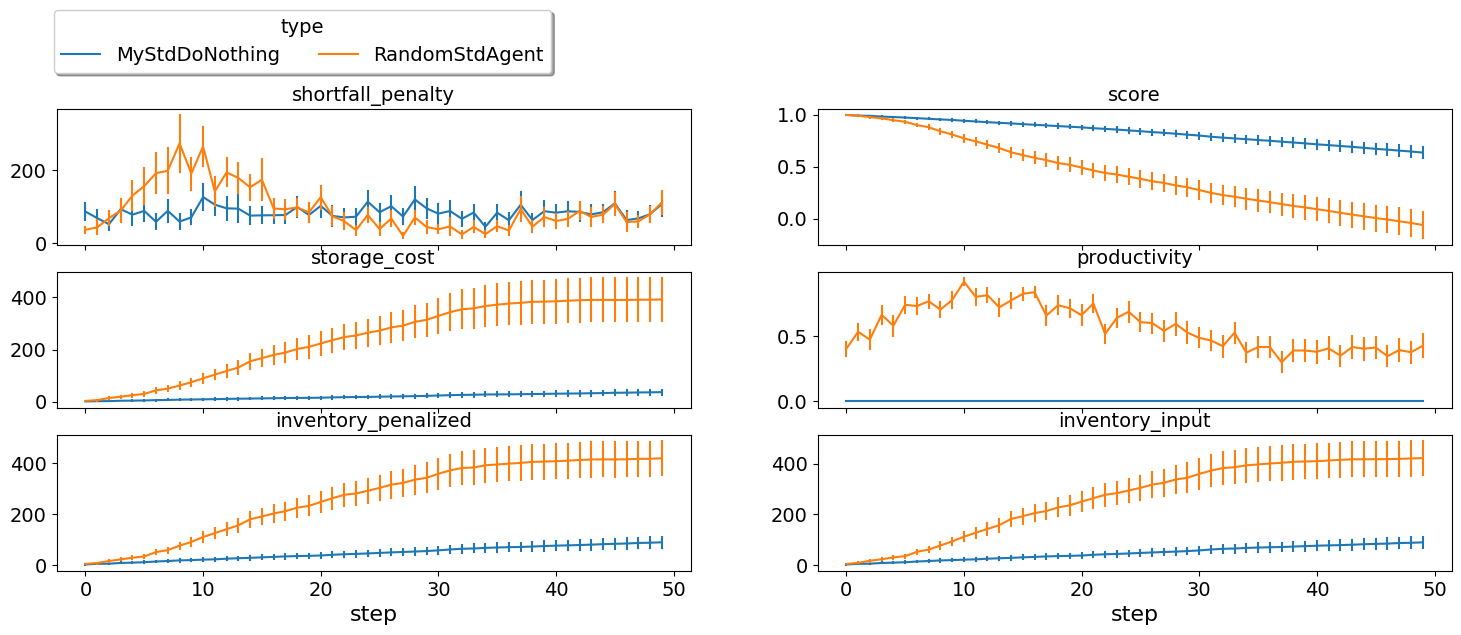
Our do-nothing agent can never makes money. That is because it cannot get any contracts from negotiation to satisfy its needs from the exogenous contracts but it still have to pay for disposal cost and shortfall penalties when it is in the first or last production levels. Nevertheless, it is better than behaving randomly in a clear inversion of the situation in the SCML oneshot game. One reason is that the outcome space is too large now that behaving randomly is almost never going to get you good contracts (no contracts will be better). Another reason is that agents in the middle of the production graph are better of not trading at all than if they acrue any imbalance between their sales and supplies which is highly likely if they behave randomly.
single_agent_runner.score_summary()
| type | score | count | mean | std | min | 25% | 50% | 75% | max | |
|---|---|---|---|---|---|---|---|---|---|---|
| 0 | MyStdDoNothing | 0.634120 | 30.0 | 0.634120 | 0.303902 | 0.123079 | 0.504789 | 0.704111 | 0.878543 | 1.000000 |
| 1 | RandomStdAgent | -0.061693 | 30.0 | -0.061693 | 0.708594 | -1.504509 | -0.510917 | -0.183504 | 0.474423 | 0.981504 |
We can also have a look at the exogenous contracts that drive the market.
def analyze_contracts(worlds, exogenous_only=True):
"""
Analyzes the contracts signed in the given world
"""
dfs = []
for world in worlds:
dfs.append(pd.DataFrame.from_records(world.saved_contracts))
data = pd.concat(dfs)
if exogenous_only:
data = data.loc[
(data["seller_name"] == "SELLER") | (data["buyer_name"] == "BUYER"), :
]
return data.groupby(["seller_name", "buyer_name"])[["quantity", "unit_price"]].agg(
dict(quantity=("sum", "count"), unit_price="mean")
)
analyze_contracts(single_agent_runner.worlds_of())
| quantity | unit_price | |||
|---|---|---|---|---|
| sum | count | mean | ||
| seller_name | buyer_name | |||
| 08SRS@2 | BUYER | 582 | 210 | 44.285714 |
| 09Gr@2 | BUYER | 1092 | 282 | 44.340426 |
| 10Ra@2 | BUYER | 1536 | 300 | 44.840000 |
| 10SRS@2 | BUYER | 2928 | 300 | 48.800000 |
| 11MSD@2 | BUYER | 1143 | 150 | 46.360000 |
| 11Ra@2 | BUYER | 1635 | 360 | 46.800000 |
| 12Gr@2 | BUYER | 4158 | 846 | 44.843972 |
| 12Ra@2 | BUYER | 2808 | 588 | 45.948980 |
| 12SRS@2 | BUYER | 2988 | 300 | 33.380000 |
| 13Gr@2 | BUYER | 6270 | 864 | 43.750000 |
| 13Ra@2 | BUYER | 7752 | 1188 | 43.156566 |
| 14Gr@2 | BUYER | 1206 | 288 | 44.666667 |
| 14MSD@2 | BUYER | 1527 | 150 | 45.780000 |
| 14Ra@2 | BUYER | 8979 | 1050 | 41.928571 |
| 14SRS@2 | BUYER | 2052 | 540 | 45.722222 |
| 15Gr@2 | BUYER | 1710 | 294 | 45.959184 |
| 15MSD@2 | BUYER | 1416 | 150 | 44.040000 |
| 15Ra@2 | BUYER | 9714 | 1338 | 42.439462 |
| 15SRS@2 | BUYER | 1878 | 492 | 47.243902 |
| 16MSD@2 | BUYER | 744 | 141 | 45.340426 |
| 16Ra@2 | BUYER | 6216 | 999 | 45.468468 |
| 16SRS@2 | BUYER | 1194 | 294 | 47.489796 |
| 17Gr@2 | BUYER | 3666 | 816 | 45.294118 |
| 17Ra@2 | BUYER | 2484 | 300 | 46.260000 |
| 17SRS@2 | BUYER | 1272 | 282 | 46.234043 |
| 18Ra@2 | BUYER | 2616 | 576 | 44.447917 |
| 18SRS@2 | BUYER | 3114 | 594 | 46.525253 |
| 19Gr@2 | BUYER | 4224 | 816 | 45.977941 |
| 19SRS@2 | BUYER | 2046 | 300 | 42.620000 |
| 20Ra@2 | BUYER | 2238 | 300 | 48.420000 |
| 20SRS@2 | BUYER | 3912 | 594 | 44.636364 |
| 21Gr@2 | BUYER | 1500 | 288 | 47.312500 |
| 21SRS@2 | BUYER | 2190 | 546 | 44.681319 |
| 22Ra@2 | BUYER | 2034 | 288 | 46.208333 |
| 22SRS@2 | BUYER | 2142 | 294 | 42.204082 |
| SELLER | 00Gr@0 | 5334 | 852 | 10.190141 |
| 00MSD@0 | 840 | 141 | 10.191489 | |
| 00Ra@0 | 3084 | 681 | 10.207048 | |
| 00SRS@0 | 5160 | 1014 | 10.112426 | |
| 01Gr@0 | 2808 | 300 | 9.920000 | |
| 01Ra@0 | 5532 | 864 | 10.118056 | |
| 01SRS@0 | 10386 | 1662 | 10.119134 | |
| 02Gr@0 | 12000 | 1476 | 10.060976 | |
| 02Ra@0 | 672 | 228 | 9.763158 | |
| 02SRS@0 | 8580 | 1146 | 9.790576 | |
| 03Gr@0 | 6228 | 870 | 9.813793 | |
| 03MSD@0 | 894 | 150 | 10.120000 | |
| 03Ra@0 | 4422 | 672 | 9.937500 | |
| 03SRS@0 | 9336 | 1164 | 9.881443 | |
| 04Gr@0 | 2526 | 300 | 10.000000 | |
| 04MSD@0 | 417 | 105 | 9.742857 | |
| 04Ra@0 | 4401 | 903 | 10.156146 | |
| 04SRS@0 | 6888 | 1074 | 9.944134 | |
| 05Gr@0 | 1890 | 288 | 10.104167 | |
| 05Ra@0 | 4770 | 522 | 9.919540 | |
| 05SRS@0 | 10926 | 1368 | 10.118421 | |
| 06Gr@0 | 5238 | 846 | 10.021277 | |
| 06MSD@0 | 507 | 129 | 9.883721 | |
| 06Ra@0 | 2595 | 429 | 9.993007 | |
| 06SRS@0 | 2382 | 498 | 9.975904 | |
| 07Gr@0 | 1800 | 288 | 10.020833 | |
| 07Ra@0 | 1506 | 288 | 10.354167 | |
| 07SRS@0 | 1692 | 270 | 10.088889 | |
There are few things to note about the distribution of the exogenous contracts:
The unit price of the raw material is always lower than that of the final product. This is the source of profitability in this market.
Each agent has a different mean and standar deviation for the quantities in its exogenous contracts. This means that different agents will have different utility functions but these utility functions for different steps are related because the exogenous contract is sampled from some common distribution for each agent for all the steps which makes learning more useful in the game.
Building your own agent
A standard agent needs only to do negotiation. The simplest possible
version (MyDoNothingAgent above) just responded to offers from its
partners and proposed new offers to them.
Your AWI
As described in a previous tutorial, your agent can sense and act in the simulation by accessing methods and properties of its AWI which is accessible at any time as:
self.awi
You can see all of these methods and properties specific for the StdAWI and its descendents here.
Your ufun
The Std game has the advantage that it is possible at the end of each simulation step (day) to calculate exactly the profit you will be getting for the set of contracts you have (either through negotiation or as exogenous contracts). We provide a utility function class (StdUtilityFunction which can be used normally as any NegMAS UtilityFunction. This ufun is available to your all the time (a new one is created for each simulation step) and is accessible as:
self.ufun
The most important services this ufun class provides for you are the following:
from_offers: This method receives a list of outcomes and a list of booleans indicating whether each of them is for buying or for selling. It returns to you the profit you will get if all of these outcomes and nothing else became contracts. An outcome is just a tuple (quantity, delivery time, unit price). You can use this callback during negotiation to judge hypothetical agreements with your partners. Note that only offers to be delivered today will be consideredfrom_contracts: This method is the same asfrom_offersbut it receives a list ofContractobjects. It is useful after all negotiations are finished to calculate the profit you will be getting for this step. Note that only contracts to be delivered today will be consideredis_breach: will tell you whether or not getting the given total input and output quantities will make you cause a breach. Notice that breaches are expected in the Standard track as any mismatch in the quantities of inputs and outputs will constitute a breach.breach_level: returns a value between zero and one specifying the level of breach that will be recorded for a given total input and output quantities.find_limit: finds either the maximum or the minimum possible profit (minimum profit is maximum loss) attainable in the current simulation step (day). This is useful when you want to normalize utility values between zero and one. Two of the agents we will develop during this tutorial will use this feature.max_utility,min_utility: give the maximum and minimum utilities/profits attainable. Note that you must prepare them by callingfind_limit. We will go into how to do that later.best,worst: give more information about the cases of maximum and minimum profit (i.e. the total input and output quantity needed, the prodcible quantity, best possible prices for buying and selling, etc). Again, these are not available except after callingfind_limit.
Your callbacks
Your agent needs to implement methods that are called by the system at various time during the negotiation. You can find a full list in the game description.
The most important ones are:
init()called once at the beginning of the simulation (i.e. before the first day starts). At this point, your AWI is set but you should not assume anything else.before_step()called at the beginning of every day. At this point, yourufunis set and market information is available.step()called at the end of every day. You can use this to analyze what happened during the day and modify your strategy in the future.on_negotiation_success()/on_negotiation_failure()called after each negotiation is concluded to let you know what happened in it.Depending on your base-class, you will also need to implement methods that allow you to control negotiations. These will be explained in details in the following sections but here is a summary:
StdAgent If your agent is based on
StdAgent, you will get apropose()call when you need to offer something to one of our partners during negotiation andrespond()when asked to respond to one of its offers.StdSyncAgent If your agent is based on
StdSyncAgentyou will get a call tofirst_proposals()once every day to set your first proposal in all negotiations and acounter_all()call to counter offers from your partners. The system will try to always give you one offer from each partner in thecounter_all()call but that is not guaranteed and sometimes it may be called with a subset of the offers.
Now we can start working on our agent.
There are two base classes for standard agents (StdAgent, and
SyncStdAgent). We will discuss them in more details in what follows.
StdAgent
This is the base class of all agents for SCML-Std. SyncStdAgent
inherit from this class and provide support for a simplified way of
developing your agent (or so we think). It is perfectly OK to use
StdAgent directly as the base of your agent.
We have already seen the StdAgent class for which you need to
override propose and may also override respond to handle
negotiations independently. The propose method receives the
negotiation state (an object of the type SAOState including among
other things the current negotiation step, relative time, last offer,
etc) and is required to return an Outcome (See negmas
documentation) as an offer. The respond method receives a
negotiation state and an offer (Outcome) from the opponent and needs
to respond to it by a decision from the ResponseType enumeration
(REJECT_OFFER, ACCEPT_OFFER, and END_NEGOTIATION). Other
than these two negotiation related callbacks, the agent receives an
init call just after it joins the simulatin and a step call
after each step. The agent is also informed about failure/success of
negotiations through the
on_negotiation_success/on_negotiation_failure callbacks. That is
all. A one-shot agent needs to only think about what should it do to
respond to each of these six callbacks. All of these callbacks except
propose are optional.
Simple StdAgent
We have already seen how to develop a do-nothing agent using the
StdAgent class. Let’s try to develop some more meaningful agent
using the same base class.
class SimpleAgent(StdAgent):
"""A greedy agent based on StdAgent"""
def __init__(self, *args, production_level=0.25, future_concession=0.1, **kwargs):
super().__init__(*args, **kwargs)
self.production_level = production_level
self.future_concession = future_concession
def propose(self, negotiator_id: str, state):
return self.good_offer(negotiator_id, state)
def respond(self, negotiator_id, state, source=""):
# accept any quantity needed at a good price
offer = state.current_offer
return (
ResponseType.ACCEPT_OFFER
if self.is_needed(negotiator_id, offer)
and self.is_good_price(negotiator_id, offer, state)
else ResponseType.REJECT_OFFER
)
def is_needed(self, partner, offer):
if offer is None:
return False
return offer[QUANTITY] <= self._needs(partner, offer[TIME])
def is_good_price(self, partner, offer, state):
# ending the negotiation is bad
if offer is None:
return False
nmi = self.get_nmi(partner)
if not nmi:
return False
issues = nmi.issues
minp = issues[UNIT_PRICE].min_value
maxp = issues[UNIT_PRICE].max_value
# use relative negotiation time to concede
# for offers about today but conede less for
# future contracts
r = state.relative_time
if offer[TIME] > self.awi.current_step:
r *= self.future_concession
# concede linearly
if self.is_consumer(partner):
return offer[UNIT_PRICE] >= minp + (1 - r) * (maxp - minp)
return -offer[UNIT_PRICE] >= -minp + (1 - r) * (minp - maxp)
def good_offer(self, partner, state):
nmi = self.get_nmi(partner)
if not nmi:
return None
issues = nmi.issues
qissue = issues[QUANTITY]
pissue = issues[UNIT_PRICE]
for t in sorted(list(issues[TIME].all)):
# find my needs for this day
needed = self._needs(partner, t)
if needed <= 0:
continue
offer = [-1] * 3
# ask for as much as I need for this day
offer[QUANTITY] = max(min(needed, qissue.max_value), qissue.min_value)
offer[TIME] = t
# use relative negotiation time to concede
# for offers about today but conede less for
# future contracts
r = state.relative_time
if t > self.awi.current_step:
r *= self.future_concession
# concede linearly on price
minp, maxp = pissue.min_value, pissue.max_value
if self.is_consumer(partner):
offer[UNIT_PRICE] = int(minp + (maxp - minp) * (1 - r) + 0.5)
else:
offer[UNIT_PRICE] = int(minp + (maxp - minp) * r + 0.5)
return tuple(offer)
# just end the negotiation if I need nothing
return None
def is_consumer(self, partner):
return partner in self.awi.my_consumers
def _needs(self, partner, t):
# find my needs today
if self.awi.is_first_level:
total_needs = self.awi.needed_sales
elif self.awi.is_last_level:
total_needs = self.awi.needed_supplies
else:
total_needs = self.production_level * self.awi.n_lines
# estimate future needs
if self.is_consumer(partner):
total_needs += (
self.production_level * self.awi.n_lines * (t - self.awi.current_step)
)
total_needs -= self.awi.total_sales_until(t)
else:
total_needs += (
self.production_level * self.awi.n_lines * (self.awi.n_steps - t - 1)
)
total_needs -= self.awi.total_supplies_between(t, self.awi.n_steps - 1)
# subtract already signed contracts
return int(total_needs)
single_agent_runner(SimpleAgent);
Let’s see how well did this agent behave:
single_agent_runner.score_summary()
| type | score | count | mean | std | min | 25% | 50% | 75% | max | |
|---|---|---|---|---|---|---|---|---|---|---|
| 2 | SimpleAgent | 0.718652 | 30.0 | 0.718652 | 0.626017 | -0.840914 | 0.827423 | 0.999168 | 1.043844 | 1.212995 |
| 0 | MyStdDoNothing | 0.634120 | 30.0 | 0.634120 | 0.303902 | 0.123079 | 0.504789 | 0.704111 | 0.878543 | 1.000000 |
| 1 | RandomStdAgent | -0.061693 | 30.0 | -0.061693 | 0.708594 | -1.504509 | -0.510917 | -0.183504 | 0.474423 | 0.981504 |
single_agent_runner.plot_stats(agg=False, legend_ncols=5);
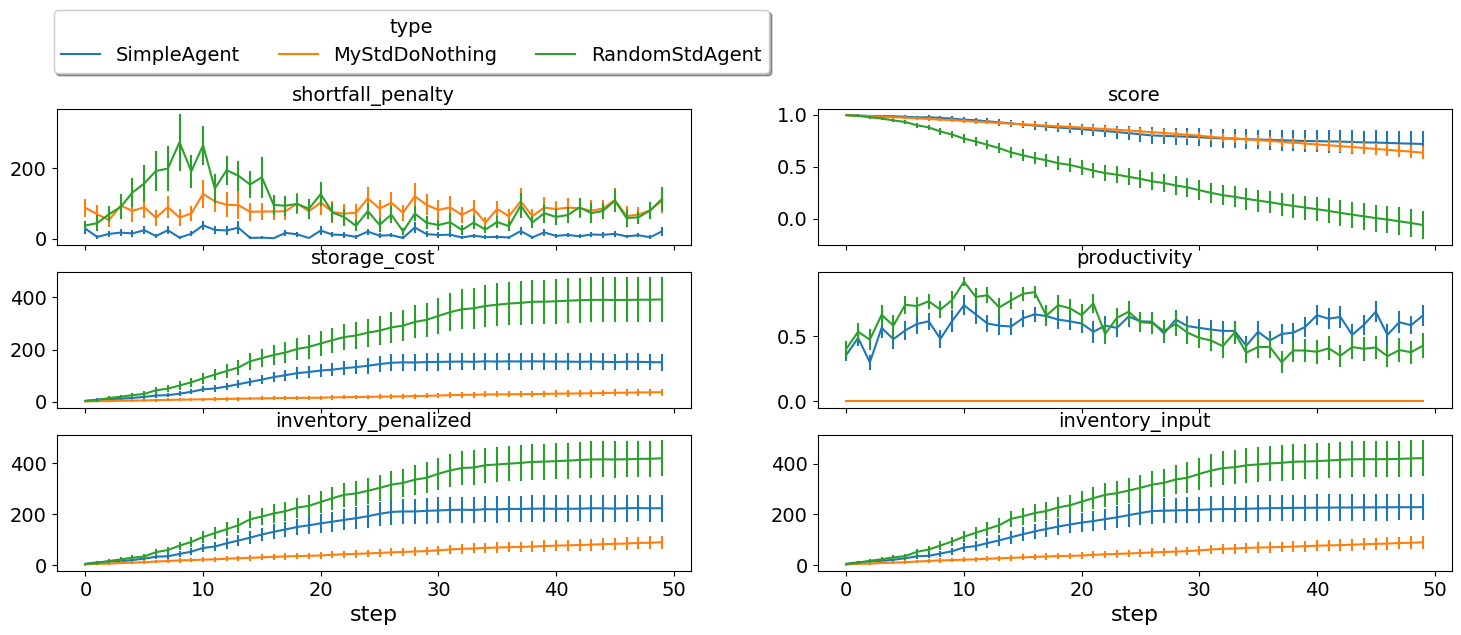
This simple agent is better than the random agent. Let’s understand how it works:
The main idea of this agent is pretty simple. It tries to secure as much of its needs (sales/supplies) as possible in every negotiation at the best possible price for itself conceding on price over time. Once today’s needs are secure it tries to secure some of what expects to need in the future.
Here is the full implementation of propose:
def propose(self, negotiator_id: str, state) -> "Outcome":
return self.good_offer(negotiator_id)
The agent concedes in price and finds the best quantity to offer (and
the best day to offer the delivery) in the good_offer() method which
we will explain later.
The respond method is also verys simple:
def respond(self, negotiator_id, state, source=""):
offer = state.current_offer
return (
ResponseType.ACCEPT_OFFER
if self.is_needed(negotiator_id, offer)
and self.is_good_price(negotiator_id, offer, state)
else ResponseType.REJECT_OFFER
)
It simply accepts the offer if it is needed and had a good price and rejects it otherwise. Note that this agent never ends a negotiation because it can always just keep rejecting everything but maybe a good offer will come later.
The agent needs three main subroutines: - is_needed() to decide if
an offer is needed. - is_good_price() to decide if the price is good
given the delivery date and quantity offered. - good_offer() to
generate a good offer.
All of these subroutines need to know how much an agent needs to
buy/sell to a given negotiator at agiven delivery date which is what
_needs() does. We start by discecting this method:
The first step is to find our total needs today which depends on our location in the supply chain:
if self.awi.is_first_level:
total_needs = self.awi.needed_sales
elif self.awi.is_last_level:
total_needs = self.awi.needed_supplies
else:
total_needs = self.production_level * self.awi.n_lines
If we are in the first or last level, we can directly read our needs
from the AWI. For agents in the middle of the supply chain, these
needs will read zero as it can just do nothing. To make some profit, we
set a production level (25% in this example) and assume that we always
need to buy and sell enough to achieve this level of production. This
what the last line above does.
This is just what we need to buy/sell today. We then need to convert
that into what we are expecting to need by the time t passed to
_needs(). This depends on whether we are negotiating with a consumer
or a supplier. If it is a consumer, we need to add the expected
production until the time t and then subtract whatever sales we
already secured until t:
total_needs += self.production_level * self.awi.n_lines * (t - self.awi.current_step)
total_needs -= self.awi.total_sales_until(t)
If it is a supplier, we need to add what we expect to produce after
time t and subtract any supplies we secured after t:
total_needs += self.production_level * self.awi.n_lines * (self.awi.n_steps - t - 1)
total_needs -= self.awi.total_supplies_between(t, self.awi.n_steps - 1)
Now that we know how to calcualte the quantity we should buy/sell at any day, we can go back into our three subroutines:
is_needed() is the simplest as it just checks if the quantity in the
offer is less than or equal the needs at the delivery date offered:
return offer[QUANTITY] <= self._needs(partner, offer[TIME])
is_good_price() is also simple. We find the relative time in the
negotiation (r). The nearer are we to the end of the negotiation, we
simply accept worse prices (higher for buying and lower for selling):
if self.is_consumer(partner):
return offer[UNIT_PRICE] >= minp + (1 - r) * (maxp - minp)
return -offer[UNIT_PRICE] >= -minp + (1 - r) * (minp - maxp)
Moreover, we concede less if this offer is about he future (because we can have other chances to negotiate a better deal):
r = state.relative_time
if offer[TIME] > self.awi.current_step:
r *= self.future_concession
Finally, we need to generate good offers in good_offer(). The main
idea here is to always try to satisfy what we need today before tomorrow
and tomorrow before the day after. That is why we loop over delivery
days from now to the negotiation horizon:
for t in sorted(list(issues[TIME].all)):
...
For each delivery day, we start by finding our needs using _needs()
and offer as much of it as we can:
offer[QUANTITY] = max(min(needed, qissue.max_value), qissue.min_value)
The only remaining issue is price. We simply concede linearly (as we did
in is_good_price()) depending on the relative time in the
negotiation (taking care to concede only to 10% of what we can for
future contracts). This code is very similar to what we showed before in
is_good_price().
A (suposedly) better greedy agent
One problem with our SimpleAgent is that it does not take its
standing offers into account. For example, if I need 10 items and I am
negotiating with 5 partners, I will offer all of them to give me these
10 items and I may end up securing 50 which will lead to penalties. The
following agent tries to remedie this by just assuming that all standing
offers will be accepted. This is the other extreme. In the example
above, it will just offer 10 for the first partner.
This is done in the _needs() method below. It starts by just getting
the needs the same was as in SimpleAgent:
n = super()._needs(partner, t)
but it then reduces this by whatever we currently offer after the given
time t:
n = max(0, n - v)
The rest of the code keeps track of our offers (offered_sales,
offered_supplies) for each partner at every day.
from collections import defaultdict
class OptimisticAgent(SimpleAgent):
"""A greedy agent based on SimpleAgent with more sane strategy"""
def propose(self, negotiator_id, state):
offer = self.good_offer(negotiator_id, state)
if offer is None:
return offer
offered = self._offered(negotiator_id)
offered[negotiator_id] = {offer[TIME]: offer[QUANTITY]}
return offer
def before_step(self):
self.offered_sales = defaultdict(lambda: defaultdict(int))
self.offered_supplies = defaultdict(lambda: defaultdict(int))
def on_negotiation_success(self, contract, mechanism):
partner = [_ for _ in contract.partners if _ != self.id][0]
offered = self._offered(partner)
offered[partner] = dict()
def _offered(self, partner):
if self.is_consumer(partner):
return self.offered_sales
return self.offered_supplies
def _needs(self, partner, t):
n = super()._needs(partner, t)
offered = self._offered(partner)
for k, v in offered[partner].items():
if k > t:
continue
n = max(0, n - v)
return int(n)
single_agent_runner(OptimisticAgent);
Let’s see how well did this agent behave:
single_agent_runner.score_summary()
| type | score | count | mean | std | min | 25% | 50% | 75% | max | |
|---|---|---|---|---|---|---|---|---|---|---|
| 3 | SimpleAgent | 0.718652 | 30.0 | 0.718652 | 0.626017 | -0.840914 | 0.827423 | 0.999168 | 1.043844 | 1.212995 |
| 1 | OptimisticAgent | 0.715633 | 30.0 | 0.715633 | 0.595175 | -0.833523 | 0.806630 | 0.972029 | 1.036741 | 1.183959 |
| 0 | MyStdDoNothing | 0.634120 | 30.0 | 0.634120 | 0.303902 | 0.123079 | 0.504789 | 0.704111 | 0.878543 | 1.000000 |
| 2 | RandomStdAgent | -0.061693 | 30.0 | -0.061693 | 0.708594 | -1.504509 | -0.510917 | -0.183504 | 0.474423 | 0.981504 |
single_agent_runner.plot_stats(agg=False, legend_ncols=4);
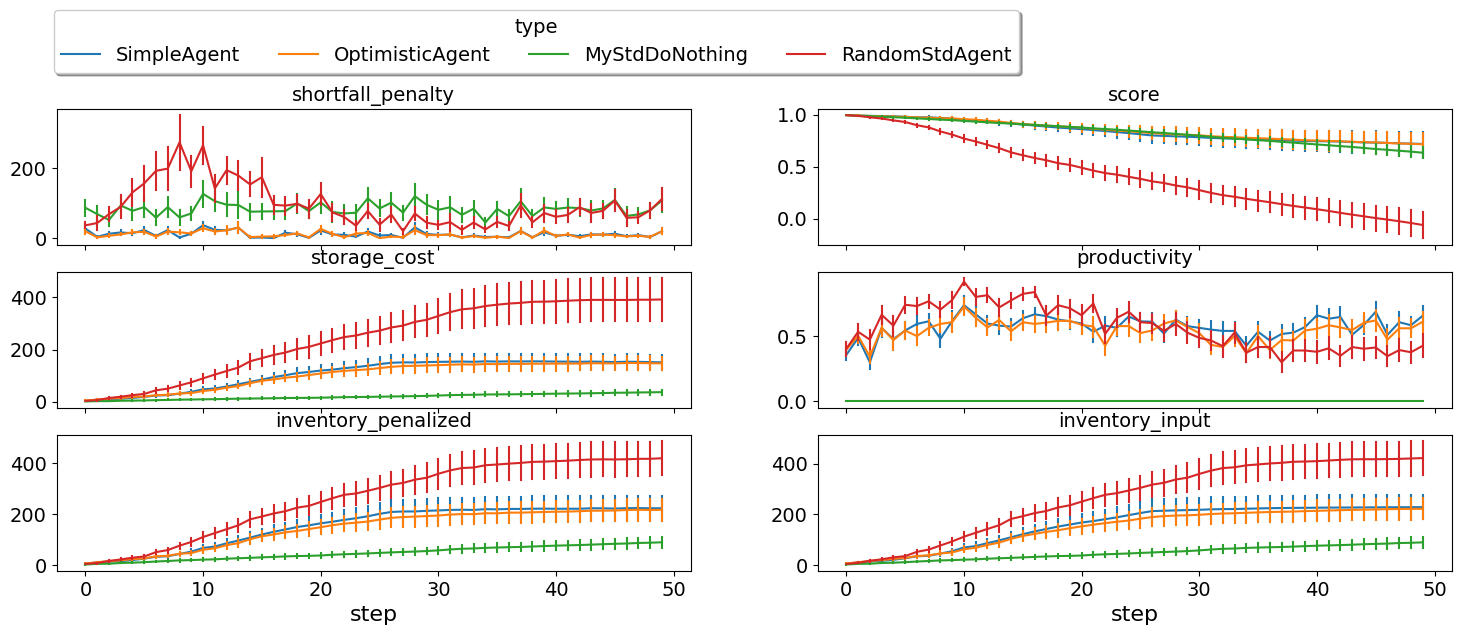
It seems that OptimitisticAgent is getting a higher score compared
with SimpleAgent. Of course this is only guaranteed in the given
configs. Note that OptimisticAgent is kind of over optimistic as
it counts anything it offers as if it was accepted. A balance is
needed. Maybe you can find a better wat to achieve this balance.
Moreover, the decision to just count any standing offer in the future
when deciding needs is kind of arbitrary. We can do better.
Simple Sync Agent
One problem that plagued all of our agents so far is that they have to
make decisions (respond, propose) about negotiations on the
spot. This makes it difficult to consider all other negotiations
while making decisions.
Because the utility function is defined for a complete set of
negotiation agreements and not for any single negotiation by itself,
it makes sense to try to make decisions centrally by collecting
offers from partners then responding to all of them at once. It is
possible to do that by utilizing the response type ResponseType.WAIT
supported by NegMAS but this entails a lot of house-keeping.
To simplify this task, we provide another base class for agents that does all of this house keeping for you exposing a simple interface that syncrhonizes all negotiations (as much as allowed by the underlying platform). The main goal of this base agent is to allow the developer to think about all negotiations together but it has some important caveats which we will discuss later. Here is an example of writing the do-nothing agent in this form:
class MySyncOneShotDoNothing(StdSyncAgent):
"""My Agent that does nothing"""
def counter_all(self, offers, states):
"""Respond to a set of offers given the negotiation state of each."""
return dict()
def first_proposals(self):
"""Decide a first proposal on every negotiation.
Returning None for a negotiation means ending it."""
return dict()
single_agent_runner(MySyncOneShotDoNothing);
single_agent_runner.score_summary()
As you can see, in this case, we need to override counter_all to
counter offers received from all the partners and first_proposals
to decide a first offer for each partner.
Other than these two negotiation related callbacks, the agent receives
an init call just after it joins the simulatin and a step call
after each step. The agent is also informed about failure/success of
negotiations through the
on_negotiation_success/on_negotiation_failure callbacks. That is
all. A one-shot agent needs to only think about what should it do to
respond to each of these six callbacks. All of these callbacks except
counter_all and first_proposals are optional.
class SimpleSyncAgent(StdSyncAgent, SimpleAgent):
"""An agent that distributes its needs over its partners randomly."""
def first_proposals(self):
"""Decide a first proposal on every negotiation.
Returning None for a negotiation means ending it."""
return {
partner: SAOResponse(
ResponseType.REJECT_OFFER, SimpleAgent.propose(self, partner, state)
)
for partner, state in self.awi.current_states.items()
}
def counter_all(self, offers, states) -> dict:
"""Respond to a set of offers given the negotiation state of each."""
# find all responses
responses = {k: SimpleAgent.respond(self, k, s) for k, s in states.items()}
# find counter offers for rejected offers
myoffers = {
k: SimpleAgent.propose(self, k, s)
for k, s in states.items()
if responses[k] == ResponseType.REJECT_OFFER
}
# compile final responses
return {
k: SAOResponse(
responses[k],
myoffers.get(
k, offers[k] if responses[k] == ResponseType.ACCEPT_OFFER else None
),
)
for k in states.keys()
}
# needed for the way multiple inheritence work in python.
# we only need these because we inherit from `SimpleAgent`.
# future agents will not need these two functions.
def propose(self, negotiator_id, state):
return StdSyncAgent.propose(self, negotiator_id, state)
def respond(self, negotiator_id, state, source=""):
return StdSyncAgent.respond(self, negotiator_id, state, source)
single_agent_runner(SimpleSyncAgent);
single_agent_runner.score_summary()
single_agent_runner.plot_stats(agg=False, legend_ncols=3, ylegend=2);
This agent behaves exactly the same as BetterAgent. We simply just
call propose() and respond() from BetterAgent
independently for each negotiator and do not really use the fact
that we have access to all the offers and can respond to all of them
centrally now.
A better SyncAgent
We start by defining a simple helper function that distributes a given quantity \(q\) over \(n\) partners.
def distribute(q: int, n: int) -> list[int]:
"""Distributes n values over m bins with at least one item per bin assuming q > n"""
from numpy.random import choice
from collections import Counter
if q < n:
lst = [0] * (n - q) + [1] * q
random.shuffle(lst)
return lst
if q == n:
return [1] * n
r = Counter(choice(n, q - n))
return [r.get(_, 0) + 1 for _ in range(n)]
Here are few examples of how it would distribute \(10\) units over \(4\) partners
[distribute(10, 4) for _ in range(5)]
[distribute(2, 4) for _ in range(5)]
We will also need a helper function to find all subsets of a given set (powerset):
from itertools import chain, combinations, repeat
def powerset(iterable):
s = list(iterable)
return chain.from_iterable(combinations(s, r) for r in range(len(s) + 1))
Now we can define our new agent:
class ProactiveAgent(SimpleSyncAgent):
"""An agent that distributes today's needs randomly over 75% of its partners and
samples future offers randomly."""
def __init__(self, *args, threshold=None, ptoday=0.75, productivity=0.6, **kwargs):
super().__init__(*args, **kwargs)
if threshold is None:
threshold = random.random() * 0.2 + 0.2
self._threshold = threshold
self._ptoday = ptoday
self._productivity = productivity
def first_proposals(self):
# just randomly distribute my needs over my partners (with best price for me).
partners = self.negotiators.keys()
s = self.awi.current_step
distribution = self.distribute_todays_needs()
return {
k: (q, s, self.best_price(k))
if q > 0
else self.sample_future_offer(k).outcome
for k, q in distribution.items()
}
def counter_all(self, offers, states):
response = dict()
# process for sales and supplies independently
for edge_needs, all_partners, issues in [
(
self.awi.needed_supplies,
self.awi.my_suppliers,
self.awi.current_input_issues,
),
(
self.awi.needed_sales,
self.awi.my_consumers,
self.awi.current_output_issues,
),
]:
# correct needs if I am in the middle
needs = (
max(edge_needs, int(self.awi.n_lines * self._productivity))
if self.awi.is_middle_level
else edge_needs
)
# find active partners
partners = {_ for _ in all_partners if _ in offers.keys()}
# find the set of partners that gave me the best offer set
# (i.e. total quantity nearest to my needs)
plist = list(powerset(partners))
best_diff, best_indx = float("inf"), -1
for i, partner_ids in enumerate(plist):
others = partners.difference(partner_ids)
offered = sum(offers[p][QUANTITY] for p in partner_ids)
diff = abs(offered - needs)
if diff < best_diff:
best_diff, best_indx = diff, i
if diff == 0:
break
# If the best combination of offers is good enough, accept them and end all
# other negotiations
if best_diff <= self._threshold:
partner_ids = plist[best_indx]
others = list(partners.difference(partner_ids))
response.update(
{
k: SAOResponse(ResponseType.ACCEPT_OFFER, offers[k])
for k in partner_ids
}
| {k: self.sample_future_offer(k) for k in others}
)
continue
# If I still do not have a good enough offer, distribute my current needs
# randomly over my partners.
distribution = self.distribute_todays_needs()
response |= {
k: self.sample_future_offer(k)
if q == 0
else SAOResponse(
ResponseType.REJECT_OFFER, (q, self.awi.current_step, self.price(k))
)
for k, q in distribution.items()
}
return response
def distribute_todays_needs(self, partners=None) -> dict[str, int]:
"""Distributes my urgent (today's) needs randomly over some my partners"""
if partners is None:
partners = self.negotiators.keys()
# initialize all quantities to zero
response = dict(zip(partners, repeat(0)))
# repeat for supplies and sales
for is_partner, edge_needs in (
(self.is_supplier, self.awi.needed_supplies),
(self.is_consumer, self.awi.needed_sales),
):
# get my current needs
needs = (
max(edge_needs, int(self.awi.n_lines * self._productivity))
if self.awi.is_middle_level
else edge_needs
)
# Select a subset of my partners
active_partners = [_ for _ in partners if is_partner(_)]
if not active_partners or needs < 1:
continue
random.shuffle(active_partners)
active_partners = active_partners[
: max(1, int(self._ptoday * len(active_partners)))
]
n_partners = len(active_partners)
# if I need nothing or have no partnrs, just continue
if needs <= 0 or n_partners <= 0:
continue
# If my needs are small, use a subset of negotiators
if needs < n_partners:
active_partners = random.sample(
active_partners, random.randint(1, needs)
)
n_partners = len(active_partners)
# distribute my needs over my (remaining) partners.
response |= dict(zip(active_partners, distribute(needs, n_partners)))
return response
def sample_future_offer(self, partner):
# get a random future offer. In reality an offer today may be returned
nmi = self.get_nmi(partner)
outcome = nmi.random_outcome()
t = outcome[TIME]
if t == self.awi.current_step:
mn = max(nmi.issues[TIME].min_value, self.awi.current_step + 1)
mx = max(nmi.issues[TIME].max_value, self.awi.current_step + 1)
if mx <= mn:
return SAOResponse(ResponseType.END_NEGOTITAION, None)
t = random.randint(mn, mx)
return SAOResponse(
ResponseType.REJECT_OFFER, (outcome[QUANTITY], t, self.best_price(partner))
)
def is_supplier(self, partner):
return partner in self.awi.my_suppliers
def best_price(self, partner):
issue = self.get_nmi(partner).issues[UNIT_PRICE]
pmin, pmax = issue.min_value, issue.max_value
return pmin if self.is_supplier(partner) else pmax
def price(self, partner):
return self.get_nmi(partner).issues[UNIT_PRICE].rand()
As usual for agents based on
SyncStdAgent,
we need to define first_offers() and counter_all()
Generating First Offers
We simply distribute our needs for today over as many partners as possible and send random offers (at our best price) for the remaining partners. This is achieved in two steps. Firstly, we distribute our needs for today over all our partners using:
distribution = self.distribute_todays_needs()
If some of our partners are not needed (i.e. has zero quantity in
distribution), we sample random outcomes for them:
return {
k: (q, s, self.best_price(k)) if q > 0 else self.sample_future_offer(k).outcome
for k, q in distribution.items()
}
Note that we always use our best price for all offers.
We will describe how do we distribute_todays_needs and
sample_future_offer later after we describe counter offering.
Generating counter offers
This process is more involved. The main idea is to process supplies and sales separately. For each, we find a subset of partners to distribute today’s needs between them and then sample random offers for the rest (that will likely have future delivery dates). For all offers, we just use random prices. Now, we describe this process in details:
The way we handle sales and supplies separately is to loop over them separately getting the amount we need, names of partners and negotiation issues from our AWI:
for edge_needs, all_partners, issues in [
(self.awi.needed_supplies, self.awi.my_suppliers, self.awi.current_input_issues),
(self.awi.needed_sales, self.awi.my_consumers, self.awi.current_output_issues),
]:
...
The needs we get here edge_needs will not be accurate if we are in
the middle of the production graph because if we have no contracts we
will just get zero for both sides. We correct this by just assuming some
production level and use it if edge_needs was too small:
needs = int(
max(edge_needs, int(self.awi.n_lines * self._productivity))
if self.awi.is_middle_level
else edge_needs
)
We then get a random price and find the partners we are still negotiating with
partners = {_ for _ in all_partners if _ in offers.keys()}
We then consider all subsets of of offers from our partners and find out the one that gives us best match to our needs. Note that we do not consider prices at all here.
plist = list(powerset(partners))
best_diff, best_indx = float("inf"), -1
for i, partner_ids in enumerate(plist):
others = partners.difference(partner_ids)
offered = sum(offers[p][QUANTITY] for p in partner_ids)
diff = abs(offered - needs)
if diff < best_diff:
best_diff, best_indx = diff, i
if diff == 0:
break
If the mismatch in quantity we just caculated is good enough (i.e. less
than some predefined threshold), we accept the subset of offers that
generated this best match and just sample random quantities and delivery
dates for others but at our best price (using sample_future_offer).
if best_diff <= self._threshold:
partner_ids = plist[best_indx]
others = list(partners.difference(partner_ids))
response.update(
{k: SAOResponse(ResponseType.ACCEPT_OFFER, offers[k]) for k in partner_ids}
| {k: self.sample_future_offer(k) for k in others}
)
continue
If we did not accept any subset of offers, we simply distribute today’s
needs over our partners while submitting random counter offers (at best
price) to any partners we happen to assign zero quantity. This is
exactly the same as we did in first_proposals except that we use a
random price for today’s offers.
distribution = self.distribute_todays_needs()
response |= {
k: SAOResponse(ResponseType.REJECT_OFFER, self.sample_future_offer(k))
if q == 0
else SAOResponse(
ResponseType.REJECT_OFFER, (q, self.awi.current_step, self.price(k))
)
for k, q in distribution.items()
}
To complete our understanding, we need to clarify the process by which we distribute today’s needs and sample future offers.
Distributing Today’s Needs
As usual, we process sales and supplies independently:
for is_partner, edge_needs in (
(self.is_supplier, self.awi.needed_supplies),
(self.is_consumer, self.awi.needed_sales),
):
...
We correct the need for the case of being in the middle of the production graph.
needs = (
max(edge_needs, int(self.awi.n_lines * self._productivity))
if self.awi.is_middle_level
else edge_needs
)
We then get the suppliers if we are considering supplies and consumers if we are considering sales. After that, we sample randomly a predefined fraction of them.
active_partners = [_ for _ in partners if is_partner(_)]
if not active_partners or needs < 1:
continue
random.shuffle(active_partners)
active_partners = active_partners[: max(1, int(self._ptoday * len(active_partners)))]
n_partners = len(active_partners)
If we do not need anything or there are no partners, we just go to the next group of partners (if any).
if needs <= 0 or n_partners <= 0:
continue
If our needs are relativey small, we concentrate them in a smaller number of partners to keep more of them for future offers.
if needs < n_partners:
active_partners = random.sample(active_partners, random.randint(1, needs))
n_partners = len(active_partners)
Finally, we distribute today’s needs over these partners
response |= dict(zip(active_partners, distribute(needs, n_partners)))
Sampling future needs
We simply sample a random outcome
nmi = self.get_nmi(partner)
outcome = nmi.random_outcome()
Note that there is a possiblity that the delivery day here may be today but we want to be sure that the offer is in the future. To achieve that, we check for this condition and sample a new time in the future. If no such time can be found (e.g. in the very last step of the negotiation), simply end the negotiation.
t = outcome[TIME]
if t == self.awi.current_step:
mn = max(nmi.issues[TIME].min_value, self.awi.current_step + 1)
mx = max(nmi.issues[TIME].max_value, self.awi.current_step + 1)
if mx <= mn:
return SAOResponse(ResponseType.END_NEGOTITAION, None)
t = random.randint(mn, mx)
Now that we have a time in the future, we counter with an offer with the sampled quantity, time and best price.
return SAOResponse(
ResponseType.REJECT_OFFER, (outcome[QUANTITY], t, self.best_price(partner))
)
Let’s see how does this agent fair against others we developed so far:
single_agent_runner(ProactiveAgent);
single_agent_runner.score_summary()
single_agent_runner.plot_stats(agg=False, legend_ncols=5, ylegend=2);
These results show that ProactiveAgent is much better than the
SimpleSyncAgent which did not really consider all offers together.
Nevertheless, it is not as good as OptimisticAgent or
SimpleAgent. Specifically, we can see that it gets higher storage
cost which means that it seems to carry more inventory that it does not
need.
Possible Improvements
There are obvious ways to improve this agent:
We are using random prices for today’s needs (
price()). May be, we can concede on price as we did inSimpleAgent.We are always using our best price for future offers. May be, we can concede in price here but not as much as for today’s needs.
When countering offers, we should take into account the history of negotiation with each partner (in this round and previously) to make a more meaningful distribution of quantities over partners. Currently this is just random. We should also consider the probability that our offers will be accepted when deciding how to distribute the quantity we still need over our partners.
Choosing which negotiators to end the negotiation with when we need a small quantity to buy/sell, is currently random. We could try to find a way to only end negotiation with negotiators least likely to provide us with our remaining needs.
We should take the number of rounds remiaining in the negotiation into account when deciding whether to accept a subset of offers (e.g. have a higher threshold near the end of the negotiation), and when deciding what quantities to distribute over our partners (e.g. offer more than what we need near the end of the negotiation under the assumption that only some of them will be accepted).
May be consider prices more when approaching our total needs.
Comparing all agents
We can now look at all the agents we considered so far:
single_agent_runner.plot_stats(notch=True);
Let’s also add a couple of the built-in agents to the mix and see where do these fit:
for t in (GreedyStdAgent, SyncRandomStdAgent):
single_agent_runner(t)
single_agent_runner.plot_stats(notch=True, stats="score");
As you can see, GreedyStdAgent and SyncRandomStdAgent are
getting good scores but not better than the simple agents we developed
in these tutorials.
single_agent_runner.score_summary()
Out of curiosity, let’s compare these agents when each is allowed to control the whole market:
FMR = WorldRunner.from_runner(single_agent_runner, control_all_agents=True)
for t in (
SimpleSyncAgent,
MyStdDoNothing,
MySyncOneShotDoNothing,
SimpleAgent,
OptimisticAgent,
RandomStdAgent,
ProactiveAgent,
GreedyStdAgent,
SyncRandomStdAgent,
):
FMR(t)
FMR.plot_stats(notch=True, stats="score");
FMR.score_summary()
As is clear when comparing the last two tables, the relative order (specially between the best scoreing agents) is dependent on the how many agents they are allowed to control in the market. In the SCML ANAC competition, we are always assuming that the evaluated agent type can control a single agent in the market. It is interesting to note that all agents lost money on average when allowed to control the whole market (and almost all of them if we consider median score).
The way we just compared these agents is unbiased because all agents are allowed to control the same factories in the same simulation envoironment. Nevertheless, the way we evaluate agents in the official ANAC competition uses upper truncated mean not the mean nor the median when scoring agents. The best way to compare these agents in exactly the same was as in the competition is to run a tournament between them. You already learned how to do that in the previous tutorial and we will not repeate it here.
If you are running this notebook, please note that the tournament running methods ``anac2023_*`` may not work within a notebook environment. You can just move your code to a normal python script and it will run correctly
You can find all the agents available in the scml package for the
one-shot game under scml.oneshot.agents including the ones developed
in this tutorial (with some modifications):
import scml.std.agents as agents
print([_ for _ in agents.__dir__() if _.endswith("Agent")])
Download Notebook.